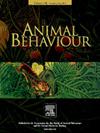Navigating a warming world: heatwave exposure during development affects responses to UV light in male bumble bees
IF 2.3
2区 生物学
Q2 BEHAVIORAL SCIENCES
引用次数: 0
Abstract
Heatwaves can create adverse conditions that impact physiological and behavioural traits in insects. Although the ability to tolerate extreme temperatures is species-specific, it also depends on factors such as life stage. Exposure to extreme temperatures during a sensitive developmental stage can have long-lasting effects in adulthood. Bumble bees are important pollinators found primarily in temperate regions. Most bumblebee species grow their colonies over the summer, when extreme heat events are most common. In this study, we investigated the effects of simulated heatwaves of two different magnitudes (32–34 °C and 36–38 °C) on microcolonies of Bombus terrestris audax. We investigated whether bumblebee workers were able to successfully thermoregulate the brood during heatwaves and assessed whether exposure to elevated temperatures during larval and pupal development affects responses to sensory stimuli of adult males. We found that workers were unable to maintain the brood temperatures within the optimal range during heatwave exposure. Our behavioural tests indicated that exposure to short-term heatwaves of 36–38 °C during the pupal stage affects the initial responses of adult males to visual ultraviolet stimulus, but we were unable to detect effects to olfactory, gustatory or mechanosensory stimuli. Finally, we did not find an effect of heatwave exposure on the body size of adult males when exposed to heatwaves as either larvae or pupae. Our results indicate that exposure to short-term heatwaves at a developmental stage closer to adulthood may cause detrimental effects on the behaviour of male bumble bees. Given the importance of males for colony foundation, additional work is strongly encouraged to understand their vulnerability in the face of climate change.
在变暖的世界中航行:发育期间的热浪暴露会影响雄性大黄蜂对紫外线的反应
热浪会造成不利条件,影响昆虫的生理和行为特征。虽然耐受极端温度的能力因物种而异,但也取决于生命阶段等因素。在敏感的发育阶段暴露在极端温度下,会对成年期产生长期影响。熊蜂是重要的传粉媒介,主要分布在温带地区。大多数熊蜂物种的蜂群都是在夏季生长的,而此时极端高温事件最为常见。在这项研究中,我们调查了两种不同程度的模拟热浪(32-34 °C和36-38 °C)对大黄蜂(Bombus terrestris audax)微群的影响。我们研究了熊蜂工蜂在热浪期间能否成功地对蜂群进行体温调节,并评估了幼虫和蛹发育期间暴露于高温是否会影响成年雄蜂对感官刺激的反应。我们发现,工蜂在热浪暴露期间无法将育雏温度维持在最佳范围内。我们的行为测试表明,蛹期暴露于36-38 °C的短期热浪会影响成年雄虫对视觉紫外线刺激的最初反应,但我们无法检测到对嗅觉、味觉或机械感觉刺激的影响。最后,我们没有发现幼虫或蛹暴露于热浪对成年雄虫体型的影响。我们的研究结果表明,在接近成年的发育阶段暴露于短期热浪可能会对雄性熊蜂的行为产生不利影响。鉴于雄蜂对蜂群基础的重要性,我们强烈建议开展更多工作,以了解它们在气候变化面前的脆弱性。
本文章由计算机程序翻译,如有差异,请以英文原文为准。
求助全文
约1分钟内获得全文
求助全文
来源期刊

Animal Behaviour
生物-动物学
CiteScore
4.60
自引率
8.00%
发文量
236
审稿时长
10.2 weeks
期刊介绍:
Growing interest in behavioural biology and the international reputation of Animal Behaviour prompted an expansion to monthly publication in 1989. Animal Behaviour continues to be the journal of choice for biologists, ethologists, psychologists, physiologists, and veterinarians with an interest in the subject.
 求助内容:
求助内容: 应助结果提醒方式:
应助结果提醒方式:


